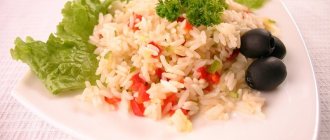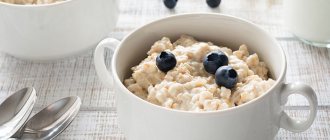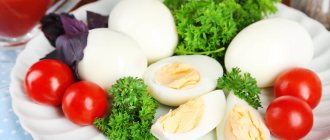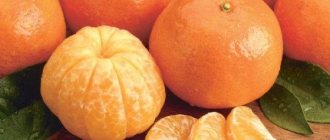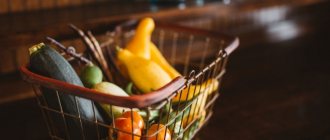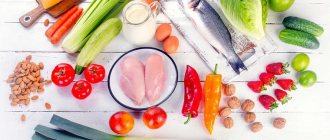The essence of the diet
The principle of losing weight on a calorie diet is that during the day the body should receive fewer calories than it burns. Thus, energy will begin to be wasted from fat deposits.
This method is considered the safest, since the kilograms will disappear slowly.
“Nothing tastes better than feeling thin” Kate Moss
BZHU: distribute correctly
An important role in weight correction is played by the correct distribution of nutrients consumed during the day. Compliance with three simple but important rules will allow you to achieve the desired result. The daily menu is compiled taking into account the fact that the calorie intake with each meal should be reduced by an average of 10-20 percent.
The diet should be composed so that most of the daily requirement of BZHU falls before lunch. Eating fast carbohydrates in the afternoon does not allow you to burn calories in full, which leads to weight gain. A light dinner consisting of protein foods will be easily digested by the body. Low-fat turkey will be complemented by non-starchy vegetables, steamed or baked in the oven. Our body spends more energy on breaking down protein foods than on digesting carbohydrates or fats. Eating foods containing large amounts of protein allows the body to spend additional calories digesting them and speeds up metabolism.
Experienced specialists of our company know how to properly distribute food and drink, and will help you create a diet for a week or a month, depending on your goals. Ordering delivery of a ready-made diet is not only convenient and profitable, but also an opportunity to switch to proper nutrition, making it your way of life. The proposed menus are compiled by experienced nutritionists who calculate the required ratio of BJU depending on the individual characteristics of each client.
Calorie calculation
The opinions of nutritionists on this issue are divided: some are convinced that the calculation is individual for each person, others offer average options.
By formulas
The most common weight loss options are based on the number of calories per day, which depend on the height, weight and age of the person wishing to lose weight. There are several formulas for calculating optimal calorie content:
Option #1
(1.8 • height, cm) + 655 + (9.6 • weight, kg) – (4.7 • age, years)
The resulting figure is the amount of energy required to maintain the body's systems.
The second stage of calculations will be to determine the physical activity coefficient. You can determine it by assessing your lifestyle:
- Passive lifestyle (sedentary) – 1.2
- Low-intensity activity (physical exercise 1-2 times a week, walking) – 1.4
- Moderate level activity (exertion more than 3 times a week) – 1.5
- High-level activity (work on the legs, systematic sports) – 1.7
- Excessive activity (heavy daily long-term exercise) – 1.9
The number after the first stage is multiplied by the selected coefficient.
The result obtained is weight stability. In order for weight to begin to decrease, you need to subtract another 400-500 kcal.
Option No. 2
30 • (height, cm – 105)
The resulting number is to save weight. To reduce it, we take away another 300-600 kcal, depending on the activity of our lifestyle.
On average
Weight loss methods from this group do not imply individual calculations, but consist of following a diet of a certain calorie content.
These include diets of 800, 1000, 1200 calories per day and other options.
What is possible and what is not
A low-calorie diet is not strict regarding the names of products. But still there are both more and less suitable foods.
Recommended Products
Ideally, the diet should include:
- Buckwheat and pearl barley porridge
- Lean meat, poultry and fish
- Cutlets, steamed meatballs
- Egg white
- Mushrooms
- Vegetable soups with light broth
- Rye bread, bran bread or wholemeal bread
- Vegetables, raw or steamed
- Low calorie fruits (apples, oranges, etc.)
- Unsweetened tea, coffee, fresh
- Fermented milk products (kefir, yogurt, cheeses)
Unwanted Products
If you wish, you can create your own diet and count calories. But it is important to remember that there are prohibited foods. If there are any, then the weight loss process will be slowed down. Among these:
- Preservation and salinity
- Smoked meats
- Sausages
- Fatty meat, poultry and fish
- Potatoes in any form
- Egg yolk
- Nuts
- Pasta
- Baking
- White bread
- Margarine, butter
- Cocoa
- High-calorie fruits and dried fruits
- Sweets (except marshmallows and marmalade)
- Sauces
You can create a menu by combining products taking into account their energy value and portion size.
Calorie content of individual products
For the convenience of calculating acceptable food combinations, you can use the table of caloric content of permitted foods.
Calorie content is indicated for the product in its raw form.
Calorie content of dishes
It is impossible to create a high-quality menu for every day without knowing the calorie content of already prepared dishes.
Calorie table for ready meals:
On a note. For convenience, it is better to print the tables and keep them for quick access.
What could go wrong
1 Disruptions due to strict regime
If you stay on proper diet for weight loss for a long time, then sooner or later “Uncle Zhora” will come. Even though the nutrition is “correct”, the menu for the week is balanced according to BJU, the body will still want to regain the lost weight. And how to do it? Make you eat it all back! The hormones needed for this will be delivered to your brain in a timely manner. This is why it is so difficult to maintain weight after a long diet.
How not to break down?
Allow yourself to “rest” sometimes. Eat something “bad” once a week (“cheat meal”). But don’t turn your “vacation” into a week-long food binge. Perhaps it is better to eat something harmful in a cafe or with friends, so that there is no temptation to continue the holiday. There are no fruits on our menu (they simply don’t fit in the calories), but they are needed in proper nutrition. For example, you can arrange a “fruit cheat meal”.
If you do break the diet, then the most important thing is not to go into the state of “well, I’ve messed up my diet anyway, you can eat 2 times more, nothing will happen for it.” With this approach, a one-time breakdown turns into a week, and then a month of continuous gluttony. No matter how hackneyed it may sound, “don’t blame yourself.” Don't pay attention to what can't be fixed. What matters is how you start eating here and now.
2 Don’t be afraid to replace products with similar ones
Nothing bad will happen, the main thing is calories. “Can I have sushi on a diet?”, “Can I have watermelon?” There are foods that we do not call “proper nutrition for weight loss” - fast food, baked goods, etc. But if you replace some product with a “harmful” one or one that is not on the standard menu, you will lose weight! Under one condition: there are no more calories per day than planned (in our menu this is 1500 kcal). For example: your planned lunch was 500 kcal. And instead you will eat sushi, which also had a total calorie content of 500 kcal. So it's okay! The only “but” is that a “proper” lunch is always more satisfying (you can eat more low-calorie food). Therefore, if you eat “harmful” foods every day, you won’t last long and you’ll break down.
3 Constant snacking
How often can you hear: “I eat so little and I can’t lose weight!” If there are no health problems, then this is not true. This means you actually eat a lot, you just don’t take into account snacks (banana, sandwich, pie at work) or count calories incorrectly, especially if you don’t eat at home. Our daily menu is everything you can eat in a day to lose weight. If you still have snacks on top, then nothing will work out.
We hope that our daily menu will help beginners lose weight and understand what’s what in proper nutrition.
Rules for creating a menu
One of the principles of the effectiveness of the diet is to eat small portions, but often. It would be optimal to split the daily diet into five times. An important point is the correct percentage of calories between meals.
Regardless of whether the calculation is based on 1000 calories per day or according to any other option, the correct ratio is considered to be:
- 25% – breakfast
- 10% – second breakfast
- 35% – lunch
- 10% – afternoon snack
- 20% – dinner
It is advisable to include in different combinations at each meal:
- For breakfast: porridge, fruit, eggs, cottage cheese, tea or coffee
- For second breakfast: fermented milk products, fruits
- For lunch: broths, soups, meat, bread, vegetables, fish, salads
- Afternoon snack: dairy products, fruits
- For dinner: meat, vegetables, fish, salads, tea
If you have a desire to eat something from the list of not recommended foods, then you don’t have to deny yourself this. The main rule is not to go beyond the daily energy value.
Recommendations
A person who decides to lose weight in calories, first of all, must decide on the value of the diet. The safest option is considered to be an individual calculation of the daily requirement. This is due to the fact that the personal characteristics of a particular person are taken into account.
If you like diets with a set calorie content, it is important to consider the following points:
- To lose weight without stress, it is better to alternate a week with critical caloric intake with a week of weight stabilization.
- It is not recommended to immediately set the bar low (800 calorie diet), as this can lead to exhaustion.
- Without harm to health, it is better not to lower the bar below 1200 kcal.
- As an exception, you can vary your daily calorie intake based on physical activity. If the day is spent passively, then you can do a fasting day and reduce the value of the diet. If the day is physically difficult, then it is appropriate to increase the calorie content to 1400 or even 2000 kcal.
- It is not advisable to be on a low-calorie diet for a long time (more than a month).
- The exit should be smooth, gradually increasing the daily calorie content by 300-500 kcal.
- Ideally, the weekly menu should include a variety of foods to get all the vitamins and minerals.
The most correct decision on choosing both the diet itself and calculating the optimal daily caloric intake is consultation with specialists. A gastroenterologist will indicate whether there are any contraindications, and a nutritionist will competently describe the nutritional scenario.
Menu for weight loss for a week/day
Below you will see a table with different menus for three days. All days can be changed between each other, and products can be replaced with similar ones in calorie content and composition; this is not a strict “weight loss diet”. Example of a menu for the week: Mon – menu #1, Tue – menu #3, Wed – menu #2, Thurs – menu #3, Fri – menu #1, Sat – menu #3, Sun – menu #2. Yes, such a plan is a ready-made correct diet for weight loss. Only it is flexible, you can change days and even squeeze your favorite products into it.
Table. Menu for weight loss
If you click on the name of the dish (in blue), you will open a page with recipes. Everything can be prepared at home, from simple ingredients.
Menu #1
Kcal 1421
BZHU 116/50/132
| Fat | Uglev | Belk | Kcal | |
| Breakfast | 5,25 | 35,08 | 25,85 | 289 |
| Cottage cheese (Low-fat), 100g | 1,84 | 3,34 | 18,01 | 101 |
| Yogurt Light 0.1%, 50g | 0,05 | 8,5 | 1,25 | 38 |
| Hercules Oat Flakes, 30g | 1,86 | 18,54 | 3,69 | 106 |
| Milk 1.5%, 100ml | 1,5 | 4,7 | 2,9 | 44 |
| Dinner | 18 | 59,47 | 49,58 | 580 |
| Chicken fillet, 170g | 2,11 | 39,25 | 187 | |
| Buckwheat, 50g | 1,7 | 35,75 | 6,62 | 172 |
| Red Sweet Pepper, 100g | 0,3 | 6,03 | 0,99 | 26 |
| Onion, 100g | 0,08 | 10,11 | 0,92 | 42 |
| Green Beans (Frozen), 100g | 0,21 | 7,58 | 1,8 | 33 |
| Sunflower Oil, 1 tbsp. l. | 13,6 | 120 | ||
| Dinner | 18,76 | 17,04 | 16,52 | 292 |
| Scrambled eggs, salad: | ||||
| Egg Yolk, 1 pc. | 4,51 | 0,61 | 2,7 | 55 |
| Egg white, 3 pcs. | 0,17 | 0,72 | 10,79 | 51 |
| Tomatoes, 1 pc. | 0,25 | 4,82 | 1,08 | 22 |
| Cucumber, 2 pcs | 0,33 | 10,89 | 1,95 | 45 |
| Olive Oil, 1 tbsp | 13,5 | 119 | ||
| Snack | ||||
| Curd Casserole, 200 g | 8,64 | 20,49 | 24,02 | 260 |
menu #2
Kcal1440
BZHU120/48/135
| Fat | Uglev | Belk | Kcal | |
| Breakfast | 3,47 | 42,65 | 21,76 | 276 |
| Curd cocktail: | ||||
| Cottage cheese (Low-fat), 100g | 1,84 | 3,34 | 18,01 | 101 |
| Hercules Oat Flakes, 20g | 1,24 | 12,36 | 2,46 | 70 |
| Banana, 1 medium (18 cm - 20 cm long) | 0,39 | 26,95 | 1,29 | 105 |
| Dinner | 17,36 | 55,32 | 58,96 | 615 |
| Pollock, 300 g | 2,4 | 51,54 | 243 | |
| Brown Rice, 50 g | 1,1 | 38,35 | 3,9 | 172 |
| Green Peas (Frozen), 50 g | 0,18 | 6,86 | 2,6 | 38 |
| Onion, 100g | 0,08 | 10,11 | 0,92 | 42 |
| Green Peas (Frozen), 50 g | 0,18 | 6,86 | 2,6 | 38 |
| Sunflower Oil, 1 tbsp. l. | 13,6 | 120 | ||
| Dinner | 18,51 | 16,26 | 15,49 | 289 |
| Omelette: | ||||
| Egg Yolk, 1 pc. | 4,51 | 0,61 | 2,7 | 55 |
| Egg white, 3 pcs. | 0,17 | 0,72 | 10,79 | 51 |
| Tomatoes, 1 pc. | 0,25 | 4,82 | 1,08 | 22 |
| Onion, 100 g | 0,08 | 10,11 | 0,92 | 42 |
| Olive Oil, 1 tbsp | 13,5 | 119 | ||
| Snack | ||||
| Curd pie, 200 g | 8,64 | 20,49 | 24,02 | 260 |
menu #3
Kcal 1465
BZHU 122/51/132
| Fat | Uglev | Belk | Kcal | |
| Breakfast | 2,21 | 33,9 | 14,76 | 212 |
| Oatmeal with proteins: | ||||
| Egg white, 3 pcs. | 0,17 | 0,72 | 10,79 | 51 |
| Hercules Oat Flakes, 30g | 1,86 | 18,54 | 3,69 | 106 |
| Apple | ||||
| Dinner | 23,96 | 61,11 | 40,65 | 615 |
| Salmon, 150 g | 22,65 | 31,19 | 337 | |
| Durum Wheat pasta, 50 g | 0,65 | 35,25 | 5,5 | 169 |
| Tomatoes, 1 pc. | 0,25 | 4,82 | 1,08 | 22 |
| Onion, 100g | 0,08 | 10,11 | 0,92 | 42 |
| Cucumber, 1 piece | 0,33 | 10,93 | 1,96 | 45 |
| Dinner | 17,56 | 21,33 | 36,33 | 382 |
| Chicken pizza (1/4 whole, with low-fat cheese) | 3,48 | 5,58 | 33,29 | 196 |
| Tomatoes, 1 pc. | 0,25 | 4,82 | 1,08 | 22 |
| Cucumber, 1 piece | 0,33 | 10,93 | 1,96 | 45 |
| Olive Oil, 1 tbsp. | 13,5 | 119 | ||
| Snack | ||||
| Curd Casserole, (coffee-lemon, 1/4 whole) | 7,55 | 15,77 | 30,32 | 256 |
How to independently create an approximate balanced menu for weight loss for a day/week?
1 Calories
You calculate your daily requirement and subtract 20-30% from it. This way you will know how many calories you need to lose weight. Daily calorie intake here
2 Balanced diet: proteins/fats/carbohydrates (BJU)
The approximate ratio of BJU with a balanced diet for weight loss is 30/30/40 (%). Those. carbohydrates – 40%, proteins and fats – 30% each.
3 Food
To create a menu for weight loss, you don’t necessarily need expensive or rare products. The most expensive item of expenditure is fresh meat, fish and vegetables. To accurately count calories, you need to cook at home, on your own. Over time, you will remember which foods contain how many calories and creating a weight loss menu for the day will become easy. If cooking at home and taking containers of food to work seems too difficult to you, then maybe you should put off losing weight for now? For those looking for an easier way, there are green coffee and goji berries. Try them first, and then switch to the side of proper nutrition and plastic containers. We don't have cookies, but we do have your slender reflection in the mirror.


